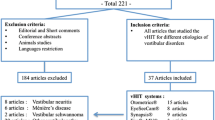Abstract
Vestibulo-ocular reflex (VOR) is an important biological reflex that controls eye movement to ensure clear vision while the head is in motion. Nowadays, VOR measurement is commonly done with a video head impulse test based on a velocity gain algorithm or a position gain algorithm, in which velocity gain is a VOR calculation on head and eye velocity, whereas position gain is calculated from head and eye position. The aim of this work is first to compare the two algorithms’ performance and to detect covert catch-up saccade, then to propose a stand-alone recommendation application for the patient’s diagnosis. In the first experiment, for ipsilesional and contralesional sides, the calculated position gain (0.94±0.17) is higher than velocity gain (0.84±0.19). Moreover, gain asymmetry of both lesion and intact sides using velocity gain is mostly higher than that from using position gain (four out of five subjects). Consequently, for subjects who have unilateral vestibular neuritis diagnosed from clinical symptoms and a vestibular function test, vestibular weakness is depicted by velocity gain much better than by position gain. Covert catch-up saccade and position gain then are used as inputs for recommendation applications.
Similar content being viewed by others
References
CREMER P, HALMAGYI G, AW S, CURTHOYS I, MCGARVIE L, TODD M, HANNIGAN I. Semicircular canal plane head impulses detect absent function of individual semicircular canals [J]. Brain, 1998, 121: 699–716.
ROY F D, TOMLINSON R D. Characterization of the vestibulo-ocular reflex evoked by high-velocity movements [J]. Laryngoscope, 2004, 114: 1190–1193.
WEBER K P, AW S T, TODD M J, MCGARVIE L A, CURTHOYS I S, HALMAGYI G M. Head impulse test in unilateral vestibular lossvestibulo-ocular reflex and catch-up saccades [J]. Neurology, 2008, 70(6): 454–463.
MACDOUGALL H G, WEBER K P, MCGARVIE L A, HALMAGYI G M, CURTHOYS I S. The video head impulse test diagnostic accuracy in peripheral vestibulopathy [J]. Neurology, 2009, 73(14): 1134–1141.
MACDOUGALL H G, MCGARVIE L A, HALMAGYI G M, CURTHOYS I S, WEBER K P. The video head impulse test (vHIT) detects vertical semicircular canal dysfunction [J]. PLoS One, 2013, 8(4): e61488.
PALLA A, STRAUMANN D, OBZINA H. Eye-position dependence of three-dimensional ocular rotation-axis orientation during head impulses in humans [J]. Experimental Brain Research, 1999, 129(1): 127–133.
WEBER K P, MACDOUGALL H G, HALMAGYIZ G M, CURTHOYS I S. Impulsive testing of semicircular-canal function using video-oculography [J]. Basic and Clinical Aspects of Vertigo and Dizziness, 2009, 1164: 486–491.
HERDMAN S J. Vestibular rehabilitation [M]. Georgia: Contemporary Perspectives in Rehabilitation. 2007.
MENDEL J. Fuzzy-logic systems for engineering-A tutorial [J]. Proceedings of the IEEE, 1995, 83(3): 345–377.
BARIN K. Video head impulse testing (vHIT): A novel test for peripheral vestibular disorders [C]// 15th Workshop on Neurotology and Medical Audiology. 2014.
BLOEDOW A, PANNASCH S, WALTHER L E. Detection of isolated covert saccades with the video head impulse test in peripheral vestibular disorders [J]. Auris Nasus Larynx, 2013, 40(4), 348–351.
MILES R. Vorteq™ VHIT [M]. Micromedical Technologies, 2013.
REY-MARTINEZ J, BATUECAS-CALETRIO A, MATIÑO E, FERNANDEZ N P. HITCal: A software tool for analysis of video head impulse test responses [J/OL]. Informa Healthcare, 2015. doi: 10.3109/00016489.
HUSSEIN A S, OMAR W M, ATI X L M. Accurate and reliable recommender system for chronic disease diagnosis [C]// 1st International Conference on Global Health Challenges. 2012.
KAWAMOTO K, HOULIHAN C A, BALAS E A, LOBACH D F. Improving clinical practice using clinical decision support systems: A systematic review of trials to identify features critical to success [J]. British Medical Journal, 330(7494), 765.
DERNONCOURT F. Fuzzy logic: Introducing human reasoning within decision-making systems? [C]// Conservatoire National des Arts et Métiers. Paris, 2011.
ROSS J T. Fuzzy logic with engineering applications [M]. Great Britain: John Wiley & Sons, Ltd. 2010.
HINES J W. MATLAB supplement to fuzzy and neural approaches in engineering [M]. A Wiley-Interscience Publication: John Wiley & Sons, Inc. 1997.
Author information
Authors and Affiliations
Corresponding author
Rights and permissions
About this article
Cite this article
Nguyen, T.A.D., Kim, D.Y., Lee, S.M. et al. Recommendation application for video head impulse test based on fuzzy logic control. J. Cent. South Univ. 23, 1208–1214 (2016). https://doi.org/10.1007/s11771-016-0370-y
Received:
Accepted:
Published:
Issue Date:
DOI: https://doi.org/10.1007/s11771-016-0370-y




